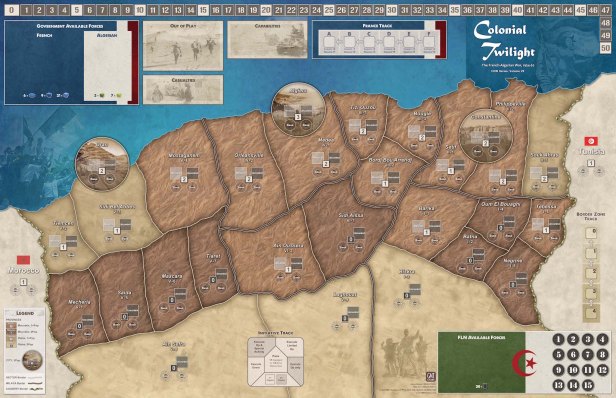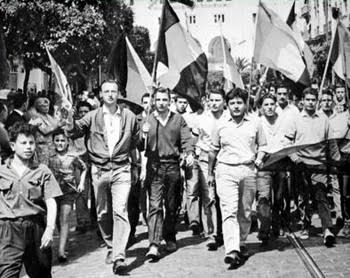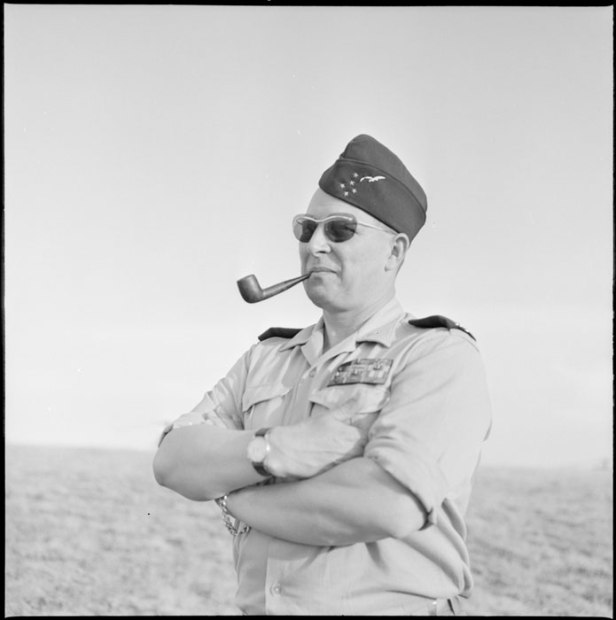
This is Part II of a 3 Part series of interviews with Brian Train regarding his newest game design in the COIN Series Colonial Twilight: The French-Algerian War, 1954-62 which is currently on P500 on the GMT Games website (http://www.gmtgames.com/p-548-colonial-twilight-the-french-algerian-war-1954-62.aspx). You can read Part I here. Now back to the interview…
Grant: What are the pieces like for the game and what is their force structure?
Brian: For the Government:
- 21 French Police (light blue): France sent hundreds of thousands of soldiers from metropolitan France to serve in Algeria: nearly half a million of them in 1958-59, the peak period. The great majority of these were conscripts and reservists who were dispersed in small outposts across the countryside in a tactic called quadrillage (after the grid-square pattern printed on military maps). These “sector troops” spent most of their time patrolling their immediate areas, waiting for something to happen – when it did, it would be a quick contact more often than not initiated by the enemy, or acting as a blocking force. It also includes numbers of regular and riot police, deployed in the cities and larger towns.
- 9 French Troops (dark blue): The great majority of the actual fighting was done by “intervention forces”, the highly trained and effective regiments of the Foreign Legion, parachute troops and naval infantry – perhaps 10% or less of the total number of French soldiers involved.
- 6 Government Bases (light blue): These represent training and logistical facilities and centres of civil administration, like the other games in the series. Bases are needed to build Support in a space, among other things.
- 3 Algerian Troops (dark green): Fearful of desertions and treachery, the French deliberately kept the number of Algerian forces small – at peak strength (1959) about 175,000 troops, or slightly over one percent of the Algerian population. The Troops are the regular Tirailleur and Spahi regiments (about 60,000 professionals and conscripts); in most cases the officer cadres were white, either French or colons (Europeans born in Algeria, also called pieds-noirs). Over time, as units were reorganized or regrouped, the ethnic proportions of the other ranks would vary (Muslim volunteers, Muslim conscripts, colons, and French volunteers) in a process called “integration”.
- 9 Algerian Police (light green): These are regular police units, moghazni (static militia organized by French civil affairs officers) and other local self-defence units and mobile security groups or militias.
Algerian Troops and Police are placed on the map by Train operations, but they are vulnerable to FLN Subvert operations. Despite the attitude of the Army, the number of non-European Algerians in French service exceeded the number of FLN combatants at all times during the War, until its very end when there were massive desertions to avoid reprisals. Not shown by separate cubes in the game are the harkis, auxiliary forces who were often attached to units of sector troops (French Police in the game), and the commandos de chasse, small (platoon to company-size) units often composed of volunteers and “turned” insurgent troops, who acted as scouts and trackers and usually worked with the intervention units (French Troops)
For the National Liberation Front (Front de Libération Nationale) or FLN:
- 30 Guerrillas (black)
- 15 Bases (black)
The FLN normally operated in platoon to at most company size units; they did have sanctuaries and training camps in Tunisia and Morocco where they could train unmolested, but they never engaged in any real pitched battles with the French.
Grant: How much thought goes into the colors for each faction’s pieces? What are the colors for the FLN and French Government?
Brian: Oh boy, colours – you’d be surprised what emotions this arouses. We had involved discussions on this on Boardgamegeek.com, Consimworld, and on the playtesting discussion site. One discussion was started because someone thought that the use of black for insurgents was a deliberate association on our part with “evil”, and they should be green (the “Muslim colour”) instead; we batted a number of schemes back and forth, and eventually settled on the scheme described above. I’m satisfied with this, as it was the scheme I started with originally, it does use green for some Muslims involved in the conflict, and most of all because these colours are distinct and remain distinct for deuteranopes (red-green colour-blindness, which affects about 8% of males).
“One discussion was started because someone thought that the use of black for insurgents was a deliberate association on our part with “evil”, and they should be green (the “Muslim colour”) instead; we batted a number of schemes back and forth, and eventually settled on the scheme described above.”
Grant: I actually was aware of those threads on Board Game Geek and thought you handled the response extremely well. Tell us about the Border Zone Track and what role it plays in the game? Also the France Track?

Brian: When Morocco and Tunisia became independent in 1956, these countries almost immediately became sanctuaries and safe rear areas for the FLN. In response, the French started building the Morice Line, to prevent infiltration to and from Morocco and Tunisia. In most places this consisted of an eight-foot tall electrified fence protected by continuous barbed wire entanglements and minefields on either side of it. The line was constantly patrolled by large numbers of soldiers, who were guided to infiltration attempts by systems of alarms, radars, searchlights and air surveillance.
In game terms, the Border Zone imposes a barrier on FLN movement into Algeria from either of the neighbouring countries. The Border Zone status, rated from 0 to 4, acts as a number of additional virtual cubes to expose (activate) guerrillas Marching across the international border, which makes them vulnerable to Assaults and Neutralizes in the following turn. The Government player must improve the Border Zone Status through Train operations, and must maintain it as well, for the status degrades during Propaganda Rounds. To a lesser extent, the Border Zone also represents the presence of the French Navy, which patrolled the Mediterranean to prevent insurgent movement and supplies into or out of Algeria by sea: in Propaganda Rounds, the FLN player loses Resources equal to twice the Border Zone status.
The Morice Line was effective but consumed a large amount of resources. Years later the United States contemplated building a similar “McNamara Line” to prevent infiltration of South Vietnam. This is reflected by a Momentum Event Card in Fire in the Lake, since it was never built on a scale large enough to become a permanent game mechanic.
Meanwhile, the France Track is a display that represents two things: first, the state of public opinion with respect to the war (usually negative), and the amount of material support the FLN gains from organized expatriate workers (usually positive). At the beginning of the conflict with the FLN in late 1954, its impact was minimized by the government and it didn’t register on the mental radar of most French people. But as the conflict grew more violent and the French government deployed large numbers of conscript soldiers to Algeria, public feeling against the war grew rapidly. It also partly accounts for the “Café Wars”, the sustained vicious struggle between the FLN and the Mouvement Nationale Algerien, its main organizational rival, as they vied for the support and monetary contributions of the hundreds of thousands of Algerian expatriates working in France.

“…the France Track is a display that represents two things: first, the state of public opinion with respect to the war (usually negative), and the amount of material support the FLN gains from organized expatriate workers (usually positive).”
In game terms, the FLN can push the France Track marker upwards in Rally Operations: at its highest point, the Government player will lose 3 Commitment and the FLN player will gain 6 Resources during Propaganda Rounds. The Government can move the France Track marker downwards in Train operations, where he will lose no Commitment and the FLN player gets minimal Resources. The France Track also degrades towards the lower end during Propaganda Rounds, so the FLN player must expend some Operations on “stoking” public opinion against the war – this is also one of the few ways he can affect Commitment directly.
Grant: Colonial Twilight is currently on P500 and I also saw the pre-order for Algeria War of Independence (also by Brian Train) and was wondering what are the overall differences between the two games?
Brian: As I mentioned, my game Algeria: the War of Independence was the first game ever published, in any language, on the war. (There is a persistent amnesia and denial by the French about that war and its effect on their politics, culture and society ever since, more thorough and profound than the American failure to come to terms with the Vietnam experience.) This was in 2000, in DTP format (desktop published: you had to mount and cut the counters yourself) through the Microgame Design Group. It was republished in 2005 by Fiery Dragon Publications, boxed and with diecut counters, and the 2015 pre-order you saw was for its third edition, in folio format with diecut counters via One Small Step Games. Each edition of the game has seen better art and higher quality components, and the 2015 version incorporates a number of significant rules and mechanical revisions and changes over the previous editions. (By the way, it’s now available from One Small Step for $24.95 at http://ossgamescart.com/index.php?main_page=product_info&products_id=77&zenid=vtbeadc2enn5hou7qigc30b9s2)
Algeria used a development of a system I had worked out for insurgencies: other games in the family (to use the term quite loosely, as there are considerable differences between the designs) include my Tupamaro (Uruguay 1968-72), Shining Path (Peru 1980-95), Andartes (Greece 1947-49) and Kandahar (Afghanistan 2009-11). In 2007-08 a professional colleague of Volko Ruhnke discovered the Fiery Dragon edition of the game and together we worked out a simpler version of the game for him to use in his classes. Volko saw the game and it gave him some ideas for what would become the COIN system; I helped playtest his Andean Abyss in 2010 and I could see he was on to something, then the game came out the following year and he name-checked me in his designer’s notes! So in a sense I’ve kind of come full circle, working on the third game ever published on the war, using a system partly inspired by the first.
Colonial Twilight features a few things ported over from the Algeria game, to reflect the nature of the conflict: there is the Neutralization special activity, the Border Zone we’ve discussed, and the Coup d’etat and OAS Pivotal Event cards are implementations of mechanics in that earlier game.
Grant: As of the writing of this interview, CT has 1,093 orders on P500 (I am one of those!). What do you think is more responsible for the early interest in the game: the theme or the 2-player design?
Brian: Colonial Twilight made its P500 in 43 days, pretty good speed – A Distant Plain took 98 days. But I think interest in the game is far more due to the fact that it’s a COIN system game (over 300 of those 500 pre-orders were in the first 72 hours; I understand there are quite a few people who have a standing pre-order of “anything COIN” with GMT) and secondarily that it’s the first one for two players. Most Americans are frankly not interested in the colonial wars of other countries; more than a few gamers have told me they weren’t even aware that France had fought a war for Algeria, until they saw this game for sale.
“But I think interest in the game is far more due to the fact that it’s a COIN system game (over 300 of those 500 pre-orders were in the first 72 hours; I understand there are quite a few people who have a standing pre-order of “anything COIN” with GMT) and secondarily that it’s the first one for two players.”
Grant: How closely did your idea in design adhere to the actual historical timeline and can you give an example?
Brian: I generally don’t like to “script” games much, I prefer to give the players about the same opening situation as was in history, with about the same factors in play, and see how they develop it. There are three scenarios in the game, that are 5, 4 and 3 Propaganda Rounds in length respectively:
- The Full scenario takes it from late 1954 or early 1955; the FLN is very small in numbers and the Government military presence is even smaller. Both sides must build up carefully and use a number of Pivotal Events to drive the action in the game – once the FLN organization reaches a certain size the Government may Mobilize, which makes the bulk of his forces available, but then Morocco and Tunisia may become independent, and so on.
- Midgame starts in 1957; both FLN and Government are at or near peak strength, with well developed sanctuaries outside of the country.
- Endgame starts in 1960: Charles de Gaulle is in power, which changes the Government player’s pacification strategy but he may attempt to depose him in a coup d’etat. The FLN strength inside Algeria is waning after the successes of the Challe Plan in 1959, but he still has large forces outside of Algeria and the political clock is winding down.

Like other historical COIN system games, almost all of the Event Cards are related to significant historical events or aspects from the actual conflict. Unlike Fire in the Lake, I did not classify them by year and left their appearance random. There are 60 standard Event Cards, so players can buzz through the deck fairly quickly.
Once again, thank you Brian for that great insight into Colonial Twilight as well as the historical setting and issues involved. Without this background, it is hard for us to understand the concepts you have worked so hard to capture in the game design. I hope that this interview will be beneficial to those who have ordered the game as well as to those that may be considering whether to order or not. In our final part of the interview, Brian will talk to us about some of the changes that have occurred with the game through the playtest process, changes in the design process for the COIN Series and he will detail many of his ongoing projects. Until then, continue to resist!
-Grant

Just to let the authors know that I read everything on your site even though I don’t comment much. Naturally your site statistics will tell you everything about visits and clicks and so on. But the stats won’t necessarily tell you how much time people spend on it.
Keep up the nice work! I especially like these interview posts. When you get some time you should probably try to interview Mark Herman about his upcoming Pericles game, which is somewhat based on his previous Churchill game.
LikeLiked by 1 person
Thanks for reading and visiting our site. I’m also glad to hear you like the interviews. Mark Herman would be an awesome interview.
LikeLike
Thanks for the kind words. Glad you enjoy the blog.
LikeLike